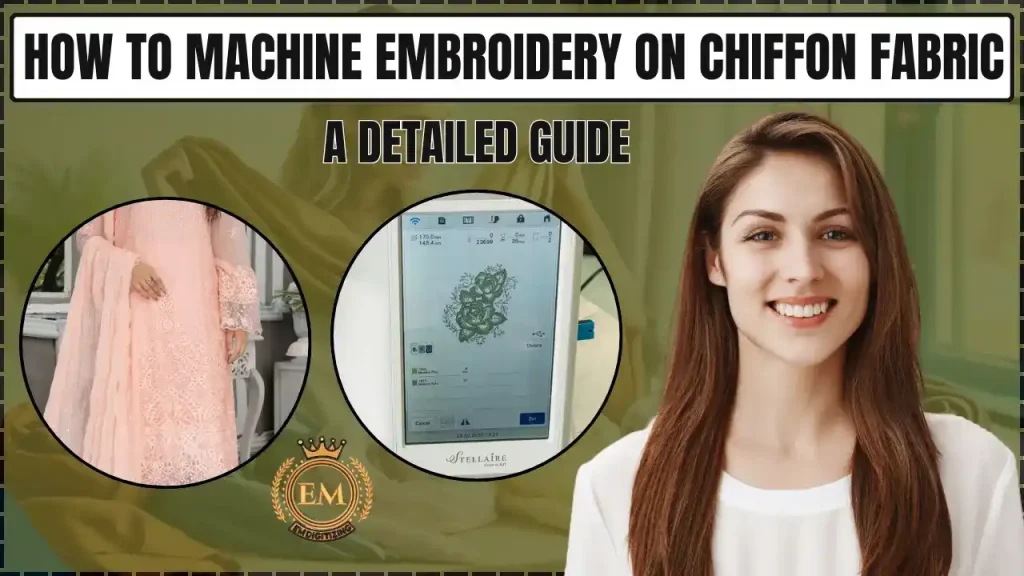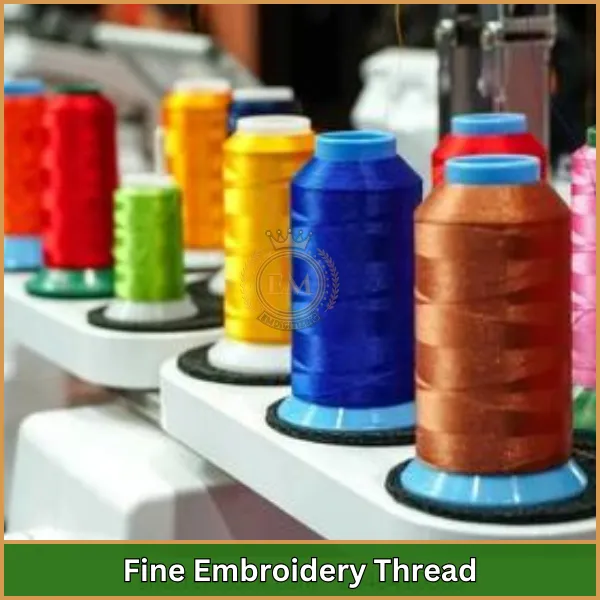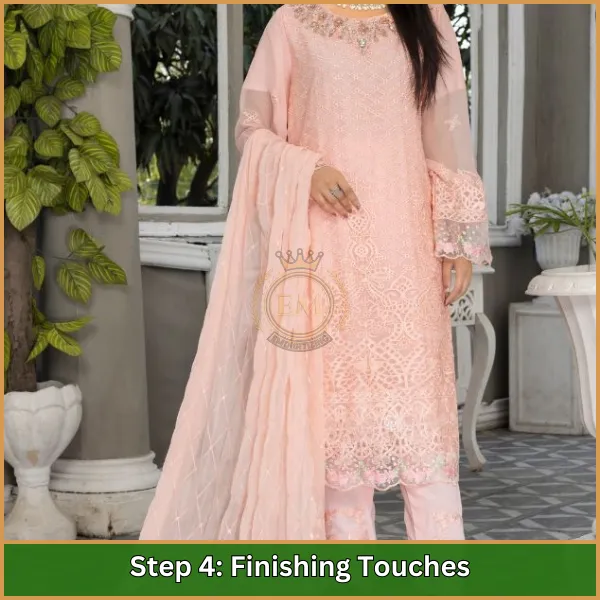La broderie de machine sur le tissu en mousseline peut ajouter une touche délicate et élégante à n'importe quel projet, Mais il vient avec ses défis. The fabric’;La nature légère et pure rend difficile de fonctionner avec, nécessiter des outils et des techniques appropriés pour éviter le pli et la distorsion.
Dans ce guide, Nous allons vous montrer comment broder avec succès sur la mousseline en couvrant tout, de la préparation aux touches finales, s'assurer que vos créations sortent magnifiquement.

Comment faire de la machine à broder sur le tissu en mousseline: Un guide détaillé
Matériaux nécessaires à la broderie sur la mousseline
Avant de commencer, it’;s essentiel pour rassembler les bons matériaux pour assurer une broderie lisse. Here’;s a quick list of the tools you’;j'aurai besoin:
- Machine à broder
- Mousseline de soie
- Stabilisateur (déchirure ou laver)
- Cercle à broder
- Aiguilles à broder (Taille 75/11 pointu)
- Fil de broderie (40-polyester de poids ou rayonne)
- Adhésive temporaire ou stabilisateur adhésif
- Ciseaux
Description détaillée de chaque matériau:
- Machine à broder: Choisissez un Machine à broder qui permet des ajustements de tension et de vitesse. La mousseline est délicate, and you’;Il faut affiner les paramètres de votre machine pour gérer le tissu sans l'endommager.

- Mousseline de soie: En tant que tissu léger et transparent, La mousseline de soie est généralement faite de soie, nylon, ou polyester. Sa fine texture nécessite une manipulation soigneuse pendant la broderie pour éviter les accrocs, pavillons, Ou des larmes.
- Stabilisateur: Le stabilisateur est critique broderie à la machine en mousseline de soie. Un stabilisateur de déchirure fonctionne bien pour les conceptions légères, Alors qu'un stabilisateur à lavage est parfait pour des conceptions plus complexes qui nécessitent un soutien supplémentaire sans quitter les résidus.

- Cerceau de broderie: Puisque la mousseline de soie est susceptible de glisser, Il est crucial d'utiliser un cerceau à broder qui contient le tissu en toute sécurité. Assurez-vous de ne pas étirer le tissu pendant ses cerveaux, Comme cela pourrait déformer votre conception.

- Aiguilles à broder: Taille 75/11 Les aiguilles pointues sont idéales pour la mousseline. Ils pénètrent en douceur le tissu délicat sans endommager ni tirer les fibres.

- Fil de broderie: Utiliser du fil léger, comme le polyester ou la rayonne de 40 poids. Ces fils ajoutent de l'élégance à la conception tout en maintenant la douceur de la mousseline.
- Spray adhésif temporaire: Pour garder la mousseline stable pendant le processus de broderie, Vous pouvez utiliser un spray adhésif temporaire pour coller le stabilisateur au tissu sans déplacer.

- Ciseaux: Petit, pointu ciseaux à broder sont essentiels pour couper les fils et couper les stabilisateurs près de la conception une fois la broderie terminée.
Processus étape par étape pour la broderie machine sur tissu en mousseline
Pour obtenir les meilleurs résultats, Suivez soigneusement ces étapes lorsque vous travaillez sur la broderie de machine sur le tissu comme la mousseline.
Marcher 1: Préparer la mousseline pour la broderie

La préparation est une première étape cruciale lors de la broderie machine sur la mousseline. Pour assurer un résultat réussi, Suivez ces sous-étapes:
- Choisir le bon stabilisateur: Utilisez un stabilisateur qui convient à la conception. Les stabilisateurs de larmes sont excellents pour les dessins légers, tandis que les stabilisateurs de lavage fonctionnent mieux pour des modèles plus complexes.
- Utilisation d'adhésif temporaire: Appliquez une fine couche de pulvérisation d'adhésif temporaire sur le stabilisateur avant de fixer la mousseline. Cela empêchera le déplacement pendant le processus de broderie et réduira le pli.
- Cerceau du tissu: Après avoir fixé le stabilisateur, Placer doucement le tissu dans le cercle à broder. Assurez-vous qu'il est plat et tendu, Mais évitez d'étirer la mousseline, car il pourrait déformer la conception finale de la broderie.
Marcher 2: Choisir la bonne conception de broderie

Lors de la sélection d'une conception pour la broderie machine sur la mousseline, Optez pour des dessins légers et aérés. Des motifs lourds ou denses peuvent provoquer un pliing ou même déchirer le tissu. Choisissez des conceptions qui complètent la nature délicate du tissu, comme les motifs floraux, formes géométriques, ou designs en dentelle.
SOUVIENS-TOI: À EMnumérisation, Nous offrons des services de numérisation de broderie professionnels adaptés à des tissus délicats comme la mousseline. Whether you’;Recherche de conceptions personnalisées ou a besoin d'aide à convertir fichiers de broderie, Notre équipe qualifiée assure des résultats de haute qualité à des prix abordables. Laissez-nous gérer les détails techniques afin que vous puissiez vous concentrer sur vos projets de broderie créatifs!
Réglage des paramètres de la machine: Baissez la vitesse et la tension sur votre machine à broder pour empêcher la mousseline de mousseline de tirer ou de déchirer pendant les coutures. Ces paramètres sont essentiels pour s'assurer que le tissu reste intact et la conception est lisse.
Marcher 3: Broder sur le tissu en mousseline

Maintenant que votre tissu est préparé et cerclé, it’;Il est temps pour commencer le processus de broderie réel.
- Exécution d'un point de test: Avant de broder sur votre projet principal, C'est une bonne idée d'exécuter un test sur un morceau de mousseline de mousseline en utilisant le même stabilisateur et le même design. Cela vous permet de vérifier la tension, couleur de fil, et s'assurer que la conception sortira comme prévu.
- Démarrage de la broderie: Commencer à coudre lentement. Puisque la mousseline est délicate, Une vitesse de couture plus lente aide à maintenir le tissu stable et à réduire le risque de pli ou de désalignement.
- Surveillance pendant la broderie: Pendant la broderie, Gardez un œil sur le processus pour vous assurer que le tissu ne change ni ne se plit. Si vous remarquez des problèmes, pause la machine et effectuer des ajustements. Ceci est particulièrement important lors de la broderie de machine sur la mousseline, Comme le tissu peut glisser ou se froisser facilement.
Marcher 4: Touches finales

Une fois votre conception terminée, Retirez soigneusement le tissu du cerceau. Manipuler doucement la mousseline pour éviter d'étirer ou d'endommager le tissu.
- Tapsage des fils lâches: Utilisez des ciseaux tranchants pour couper les fils lâches de l'avant et de l'arrière du tissu. Cela donnera à la broderie une nette, apparition professionnelle.
- Retirer le stabilisateur: Si vous avez utilisé un stabilisateur de déchirure, Déchirant soigneusement l'arrière du tissu sans tirer trop fort sur la mousseline délicate. Pour les stabilisateurs de lavage, Rincez doucement la zone avec de l'eau pour dissoudre le stabilisateur.
Dépannage des problèmes de broderie courants sur le tissu en mousseline
Même avec la meilleure préparation, Des problèmes peuvent parfois survenir lors de la broderie de machine sur la mousseline. Voici quelques problèmes courants et comment les résoudre:
- Plissage de tissu: Le pliniture se produit lorsque le tissu se déplace ou s'étire pendant la broderie. Pour éviter cela, Assurez-vous que le stabilisateur est correctement adhéré à la mousseline et que le tissu est en toute sécurité sans être étiré.
- Rupture de fil: Si le fil continue de se briser, Cela peut être dû à une tension élevée ou au mauvais type de fil. Essayez d'utiliser un fil plus léger et de réduire la tension sur votre machine.
- Points sautés: Des points sautés se produisent souvent lorsque l'aiguille est trop épaisse ou terne pour le tissu. Assurez-vous que vous utilisez une aiguille pointue (Taille 75/11) et le remplacer régulièrement pendant votre projets de broderie.
Prendre soin de la mousseline brodée

Once you’;ve a terminé votre broderie de machine sur la mousseline, it’;est important de prendre soin de la pièce brodée pour assurer sa longévité.
- Lavage: Lavage à la main dans l'eau froide avec un détergent doux. Évitez de frotter ou d'atteindre le tissu, Comme cela pourrait endommager la broderie. Appuyez doucement sur l'excès d'eau et posez le tissu plat pour sécher.
- Repassage: Si la mousseline a besoin de repasser, Faites-le avec grand soin. Réglez le fer à basse température, et placer toujours un chiffon pressant sur la broderie pour protéger les points. Évitez le repassage directement sur la zone brodée, Comme cela pourrait aplatir la conception ou endommager le fil.
Conclusion
En conclusion, if you’;En prévoyant de broder sur le tissu en mousseline, Emdigitising peut aider à rendre le processus beaucoup plus fluide. Nous offrons spécialisé services de numérisation de broderie sur mesure pour des tissus délicats comme la mousseline de soie, s'assurer que vos créations sortent sans faille et élégante.
Notre équipe d'experts peut convertir toutes les illustrations en fichiers prêts à la broderie, Parfaitement adapté à la mousseline, Vous pouvez donc vous concentrer sur les aspects créatifs de votre projet. Et en prime, Les clients pour la première fois obtiennent un 50% réduction sur leur première commande.
Contactez Emdigitisation dès aujourd'hui pour donner vie à vos conceptions de broderie en mousseline de soie!
FAQ
Oui, vous pouvez broder à la machine sur la mousseline, mais cela nécessite une manipulation et une stabilisation prudentes pour éviter le pli ou les dommages.
La broderie de machine sur le tissu transparent est possible, Utilisation d'un stabilisateur approprié pour soutenir le tissu pendant le processus de broderie.
Tissus trop extensibles, trop mince, ou trop tissé, Comme certains tricots et draps légers, peut être difficile et peut ne pas donner les meilleurs résultats de broderie.
Les meilleurs tissus pour broderie à la machine sont stables, tissus moyens-poids tels que le coton, lin, soie, et des mélanges de polyester qui fournissent une surface lisse et un étirement minimal.
